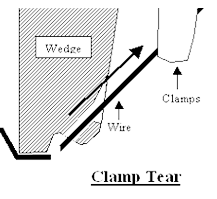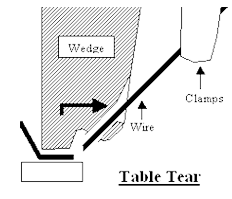TECH TIPS
Wire Termination Methods


There are two basic methods that wire bonding equipment use to terminate the wire bond. The first is called clamp tear and the second is called table tear.
Clamp Tear
Just like it sounds, the wire bonding machine uses a set of clamp blades to clamp on to the wire immediately after the last wire bond contact is made and the clamps actually move back and pull on the wire with enough force to break the wire. This wire clamp movement must be done while the bonding wedge is in contact with the wire. The tool is pressing down on the wire while the clamps are pulling on the wire.
This sequence is very important. If the wedge is not holding the pressure down on the wire, the clamp pull force would likely lift up the already bonded wire connection. How does the wire know where to break? The wire will break at its weakest point. Where is that weakest point? If we assume that the correct bonding wedge is used, the weakest location will be at the back radius of the tool. This semi-sharp portion of the tool is designed to weaken the wire strength and allow for the wire to break at a predictable location. Many manual machines and a some automatic wire bonders use this technique to terminate the wire.
Table Tear
This method still utilizes a set of clamp blades, however the clamps only clamp on the wire and do not have a motion to pull back on the wire. Instead, the wire bonding machine lifts up the wedge after the last bond is complete. This lift elevation is extremely low and is measured in just a few thousandths of an inch. After the tool lifts from the surface, the table moves such that the tool steps back and as a result breaks the wire.
Once again, how does it know where to break? The back of the bond foot has been weakened by the back radius design of our wedge. As a result of the semi-sharp back radius, the wire breaks at the desired location.
Since this wire termination method requires some motorized table movement, it is almost exclusively used on automatic wire bonders. The automatic equipment engineers like to use this method out of consideration for bonding speed. They can perform a table tear method faster than trying to perform a clamp tear sequence, because every fraction of a second is considered.
